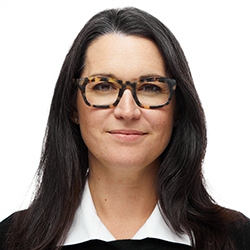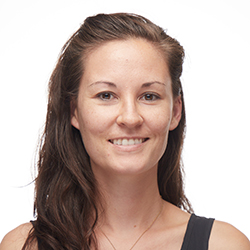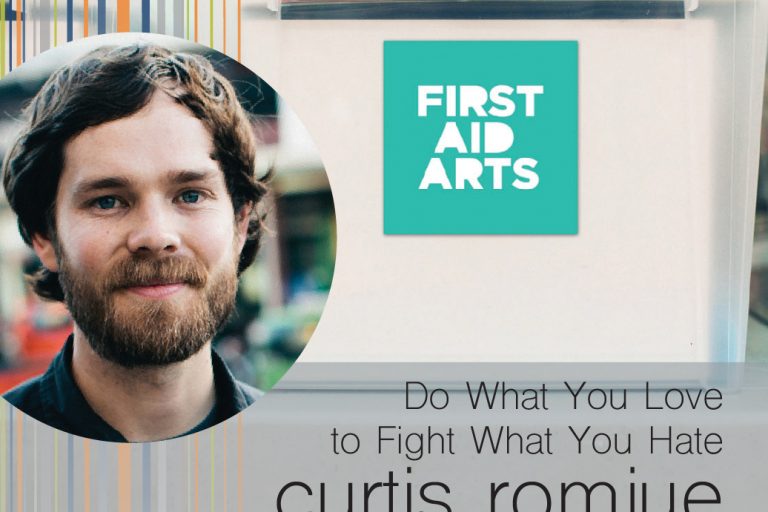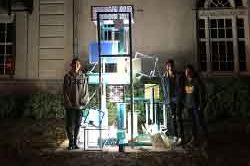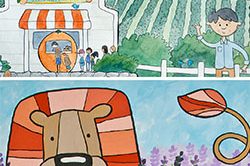
Fine Art
Fine Art
Art in Community
Art in Service of Community
CBU Fine Art program is authored and taught by professional Christian artists actively working at the highest level in their fields. Best practices, deep technical knowledge, developed artistic ideation, craft, and business acumen are embedded into the instruction and mentorship – all with the intention of sending graduates out to make an impact for the Kingdom.
CBU Fine Art program offers a flexible undergraduate degree which allows for the student to receive a solid foundation, and built on it with their choice of emphasis.
Studio Art Tracks
CBU Fine Art offers several studio art tracks, allowing students to specialize and distinguish themselves as artists who demonstrate professional excellence and personal integrity, are servant leaders in their communities, and who live Biblically-based, missional lives within the profession.
Alumni Spotlight
Geoff Gouvea
www.geoffgouveia.com
Geoff is a multi-talented artist whose recent mural work includes Facebook, Starbucks, Adidas, Coca-Cola, and more.
Most recently, Geoff has been contracted to create artwork for EA Sports FIFA20 game.
News
Ready to See Differently?
B.A. Fine Art
The Fine Art program offers a curriculum intended to stimulate creative ability, impart effective technique and foster an understanding and appreciation of the dynamic role of visual art in culture, whether defined locally or globally and grounded in a Biblical world-view. While recognizing the unique intersection of technology and tradition that has transformed the practice of visual art in our time, the program emphasizes traditional media: drawing, painting, printmaking and sculpture. The result is to provide quality professional preparation that can be realized in market-based applications and/or further graduate-level studies.
General Education Courses
The general education requirements will follow the curriculum set forth for other university programs. Some general education requirements will be met through specific major requirements.
Lower Division Requirements
ART 201 Principles of Design and Color
Units: 3. Offered: Fall, Spring.
An introduction to the principles of two-dimensional design and color theory and their use as tools for effective visual communication.
ART 208 Studio Drawing I
Units: 4. Offered: Spring.
This course functions as the introductory drawing course for Art Majors and Minors. In it, the perceptual and technical skills, and the basic media of drawing are introduced and exercised. Drawing as an historic art form is studied and used to develop a sophisticated awareness of its current expressive potential. Credit cannot be earned for ART 204 and ART 208.
ART 225 Sculpture I
Units: 3. Offered: Fall (Odd Years).
Basic elements of sculpture. Creating forms in clay, plaster, paper and multi-media techniques.
ART 232 Ceramics I
Units: 3. Offered: Fall, Spring.
Introduction to working with clay, using pinch, coil, slab and wheel; applying glazes, exploring decorating techniques using oxides. History of clay as an art form.
ART 241 Global History of Art: Ancient to Renaissance
Units: 3. Offered: Fall (Odd Years).
A survey of the history of western art from prehistoric times to the Renaissance. Lecture and slides.
ART 242 Global History of Art: Renaissance to Present
Units: 3. Offered: Fall (Even Years).
A survey of the history of western art from the Renaissance in the Fifteenth Century in Italy to the Twentieth Century in America. Lecture and slides.
ART 283 Painting I
Units: 4. Offered: Fall (Even Years).
Projects introduce traditional painting methods in oils or acrylic paints. Applied studio work, slide lectures, group discussions, and field trips are possible. May be repeated one time for credit. Prerequisite: ART 201 or ART 204.
DES 101 Design Technology Applications I
Units: 3. Offered: Fall, Spring.
This is an introduction to the essential computer software tools used in the modern production of information society, with a focus on the workflow and productions native to design oriented tasks utilized in design and allied design professions. Students will be introduced to foundational design software applications – including Adobe Photoshop, Illustrator, and InDesign – and will be introduced to other workflow applications such as word processing, presentations, spreadsheets, databases, and email. Project based learning activities will provide hands-on experiences for student to practice and apply skills to real-world situations.
DES 110 Creativity: Process and Purpose
Units: 3. Offered: Fall, Spring.
This course provides an introduction to creativity through discussion and project-based learning. The course provides overview and practice of creative processes (e.g. ideation, research, empathy, proto-typing, etc), in-depth discussion of the theological foundations for creativity, and practice for developing creative habits.
ILL 250 Digital Painting I
Units: 3. Offered: Fall.
This course will introduce digital painting methods including conceptualizing, composing, refining and evaluating digital illustration. Additionally, the course will introduce digital illustration workflows and software applications for composition, color, contrast and value as a means to broaden skill sets in storytelling. Pr-requisite: DES 101
Upper Division Requirements
ART 300 Advanced Art
Units: 4. Offered: Fall (Even Years).
An essential course for the serious art student. Projects in painting, drawing and digital media. Emphasis on developing skills and concepts. Course is designed to be repeated for credit. Section (a), emphasis in painting and drawing; section (b), emphasis in digital media using the Macintosh platform; section (c), Senior Exhibit preparation. Section (c) must be taken during student’s graduating semester. May be repeated twice for credit. Prerequisite: ART 201 or 204.
ART 301 Color, Theory and Application
Units: 4. Offered: Spring (Even Years).
This is a combination studio/lecture course that focuses exclusively on issues of color, it’s aesthetic, symbolic and psychological dimensions, as related to visual expression. This content is applicable to both fine art and design-related fields. Prerequisite: ART 201 or ARC 122.
ART 304 Perspective Drawing
Units: 4. Offered: Spring (Even Years).
This course concentrates on developing a mastery of the two principle means for creating the illusion of space on a two-dimensional surface: arial and linear perspective.
Prerequisites: ART 204 or 208
ART 305 Figure Drawing I
Units: 4. Offered: Fall (Even Years).
This course is dedicated to developing facility at rendering the human form in a variety of dry media. The context for this is drawing from live models (clothed), augmented with anatomical drawing exercises It will also introduce students to the metaphorical/expressive possibilities of the human form. Prerequisite: ART 204.
ART 325 Sculpture II OR ART 353 Ceramics II
Units: 4. Offered: .
ART 325 Sculpture II
Sculpture II is an expansion of Sculpture I. There will be an emphasis on scale and new materials such as wood, metal, and found object assemblage. A large scale collaborative object for community outreach also gets explored in this class as well as a history in object making and their various functions. Pre-Requisite: ART 225 Offered Spring (Even Year).
ART 353 Ceramics II
Developing clay as an art form; study of properties of clay, glaze and their origin; fusion of materials; stacking and loading kiln, emphasis on wheel throwing. Prerequisite: ART 232
ART 383 Painting II OR ILL 350 Digital Painting II
Units: 3-4. Offered: .
ART 383 Painting II – 4 units
Projects further develop skills learned in ART 283 – Painting I. Applied studio work, slide lectures, group discussions, and field trips are possible. Prerequisite: ART 283. Offered Spring Odd Years.
ILL 350 Digital Painting II – 3 units
This course is an advanced digital painting methods course that moves beyond basic digital workflows and software into advanced digital illustration techniques for composition, color, contrast, and value as a means to effective storytelling. Prerequisites: GDM 235 or ILL 250. Offered Spring.
ART 499 Senior Exhibition
Units: 3. Offered: Fall, Spring.
Senior Exhibition, provides unit reward for the work art majors perform en route to the creation and mounting of their required thesis exhibit. Prerequisite: Senior status and permission of the Department Chair.
DES 310 Creativity: Collaboration and Context
Units: 3. Offered: Fall.
This course builds on a foundational understanding of creativity’s process and purpose. The aim of the course is for students to apply these foundations to the act of completing interdisciplinary creative projects in context. Prerequisite: DES 110.
PHI 312 Beauty
Units: 3. Offered: Spring.
An introduction to philosophical aesthetics, which has been marginalized and often ignored in philosophical discourse during the past four hundred years. During the last few decades the questions posted by aesthetics have moved back into the center of the philosophical discussion, including the use of the concept by “post-modern” thinkers. The course seeks to bring the student into the longer conversation concerning beauty, “retrieve” important elements that have been lost, and provide a basis for further study. Prerequisite: ARC 210, ART 242, DES 310, FLM 250, GDM 310, ILL 210, PHI 213, or PHO 330.
Upper Division Art History & Theory Electives
Complete three to three (3) units from the following:
ARC 350 Architectural Theory I
Units: 3. Offered: Fall.
The purpose of this course is to enable students to understand the formation and context of various architectural ideas. This course on architectural theory provides students with a means to propose and navigate architectural discourse as a part of their development as architects. Prerequisite: ARC 242.
ART 345 Nineteenth Century Art History
Units: 3. Offered: As offered.
A study of the major developments in the visual arts in Europe from David to the first Impressionist show in 1874. Lecture and slides. Pre-Requisite: ART 241 or ART 242.
ART 346 History of Modern Painting
Units: 3. Offered: Fall.
A study of the development of modern painting from the French Impressionist movement to the present day in the United States. Lecture and slides. Pre-Requisite: ART 241 or ART 242.
ART 347 Contemporary Art History
Units: 3. Offered: As offered.
This course critically examines visual art and design on a global scale from 1945 to the present. We will consider art in the broader framework of “visual culture” which includes performance, installation, print media, video and propaganda. Prerequisite: ART 241 or ART 242
ART 350 Gallery Methods
Units: 3. Offered: Fall, Spring.
In this course students will be learn the basics of gallery design and installation. This includes general theories pertaining to the exhibition space and the evolving history of the gallery. In addition students will gain practical experience installing exhibitions. May be repeated one time for credit. Pre-requisite: ART 241 or ART 242
ART 361 Art of Latin America
Units: 3. Offered: As offered.
As an introduction to the ancient Americas, this course will focus on seven major cultures in Mesoamerica (Olmec, Teotihuacan, Maya, Aztec) and Andean South America (Chavín, Moche, and Inca). The course concludes with the arrival of Spanish explorers in the 16th century and a brief analysis of new visual forms produced in response to new social, political and religious contexts. Prerequisite: ART 241 or ART 242
ART 371 Art of Southeast Asia
Units: 3. Offered: Fall.
This course covers the development of art in India and Southeast Asia (i.e., Cambodia, Thailand, Burma (Myanmar), Vietnam, and Indonesia,) from pre-historic periods to the present. Prerequisite: ART 241 or ART 242
ART 381 Women in the Arts
Units: 3. Offered: As Offered.
This course will focus on women both as the subjects and the creators of art. It will be organized chronologically and thematically. This will involve a historical survey of women artists and their artistic contributions, as well as an examination of the religious, mythological and secular images of women in art. Extensive attention will be given to the creation, modification and persistence of these images throughout history, due to their respective religious, social, economical, psychological and intellectual conditions. Prerequisite: ART 241 or ART 242
ART 412 Topics in Art History
Units: 1-4. Offered: As offered.
Projects in Art History topics of current interest not normally covered by established courses. Content variable. May be repeated twice for credit with change of topic.
FLM 300 National Cinema
Units: 3. Offered: Spring (even years).
National Cinema is an advanced course focusing on the most significant films and filmmakers of one country. It looks at cinematic history and practice in the nation being covered and may include a consideration of popular, independent, and/or art film. The course may cover the entire history of cinema in one nation or focus on a particular type of film or cinematic movement in one country. Special attention will be paid to the socio-historical contexts of the films assigned during the course. May be taken multiple times with change in topic. Prerequisite: FLM 150.
FLM 450 World Cinema
Units: 3. Offered: Fall.
World Cinema is an advanced course focusing on films made outside of North America and their socio-historical contexts. It looks at cinematic history and practice in diverse nations and introduces students to a range of non-Hollywood film styles and forms, including popular and art cinemas, from across the globe. May be taken multiple times with change in topic. Prerequisite: FLM 250.
Student Learning Outcomes
Visual Art Student Learning Outcomes (SLO)
- Faith / Art Integration: Art Majors will engage in the practice of art as an extension of Christian ‘Being’, understood in all of its aesthetic, social and ecclesiastical dynamics.
- Visual Literacy: Art Majors will demonstrate a critical and working familiarity with the themes and concerns of contemporary art, as well as the canon of Western art and non-western traditions in their aesthetic, intellectual and spiritual implications. Evidence of this will be manifested through directed projects and their capstone exhibition.
- Creative Thinking: Art Majors will demonstrate the ability to engage in associative/spatial thinking dynamically channeled through various media through directed formal and conceptual problems as well as self-determined projects.
- Media Fluency: Art Majors will demonstrate an ability to command the inherent dynamics of a variety of 2&3 dimensional media as applied to directed and self-determined expressive goals.
- Professional Awareness: Art Majors will acquire the ability to assess the professional implications of their expressive decisions and the protocols of presentation that these varying destinations for artwork require.
Minor, Fine Art
The Fine Art minor provides students from different majors with an understanding of, and appreciation for, traditional and modern expressions of the visual arts while providing training in appropriate technologies.
Lower Division Requirements
ART 201 Principles of Design and Color
Units: 3. Offered: Fall, Spring.
An introduction to the principles of two-dimensional design and color theory and their use as tools for effective visual communication.
ART 208 Studio Drawing I
Units: 4. Offered: Spring.
This course functions as the introductory drawing course for Art Majors and Minors. In it, the perceptual and technical skills, and the basic media of drawing are introduced and exercised. Drawing as an historic art form is studied and used to develop a sophisticated awareness of its current expressive potential. Credit cannot be earned for ART 204 and ART 208.
Lower Division Studio Art Electives
Complete three to four (3-4) units from the following:
ART 225 Sculpture I
Units: 3. Offered: Fall (Odd Years).
Basic elements of sculpture. Creating forms in clay, plaster, paper and multi-media techniques.
ART 232 Ceramics I
Units: 3. Offered: Fall, Spring.
Introduction to working with clay, using pinch, coil, slab and wheel; applying glazes, exploring decorating techniques using oxides. History of clay as an art form.
ART 283 Painting I
Units: 4. Offered: Fall (Even Years).
Projects introduce traditional painting methods in oils or acrylic paints. Applied studio work, slide lectures, group discussions, and field trips are possible. May be repeated one time for credit. Prerequisite: ART 201 or ART 204.
Lower Division Art History Electives
Complete three (3) units from the following:
ART 241 Global History of Art: Ancient to Renaissance
Units: 3. Offered: Fall (Odd Years).
A survey of the history of western art from prehistoric times to the Renaissance. Lecture and slides.
ART 242 Global History of Art: Renaissance to Present
Units: 3. Offered: Fall (Even Years).
A survey of the history of western art from the Renaissance in the Fifteenth Century in Italy to the Twentieth Century in America. Lecture and slides.
Upper Division Requirements
ART 301 Color, Theory and Application
Units: 4. Offered: Spring (Even Years).
This is a combination studio/lecture course that focuses exclusively on issues of color, it’s aesthetic, symbolic and psychological dimensions, as related to visual expression. This content is applicable to both fine art and design-related fields. Prerequisite: ART 201 or ARC 122.
Upper Division Studio Art Electives
Complete eight (8) units from the following:
ART 300 Advanced Art
Units: 4. Offered: Fall (Even Years).
An essential course for the serious art student. Projects in painting, drawing and digital media. Emphasis on developing skills and concepts. Course is designed to be repeated for credit. Section (a), emphasis in painting and drawing; section (b), emphasis in digital media using the Macintosh platform; section (c), Senior Exhibit preparation. Section (c) must be taken during student’s graduating semester. May be repeated twice for credit. Prerequisite: ART 201 or 204.
ART 305 Figure Drawing I
Units: 4. Offered: Fall (Even Years).
This course is dedicated to developing facility at rendering the human form in a variety of dry media. The context for this is drawing from live models (clothed), augmented with anatomical drawing exercises It will also introduce students to the metaphorical/expressive possibilities of the human form. Prerequisite: ART 204.
ART 325 Sculpture II
Units: 4. Offered: Spring (Even Years).
Sculpture II is an expansion of Sculpture I. There will be an emphasis on scale and new materials such as wood, metal and found object assemblage. A large scale collaborative object for community outreach also gets explored in this class as well as a history in object making and their various functions. Pre-requisite: ART 225.
ART 353 Ceramics II
Units: 3. Offered: Spring .
Developing clay as an art form; study of properties of clay, glaze and their origin; fusion of materials; stacking and loading kiln, emphasis on wheel throwing. Prerequisite: ART 232.
ART 383 Painting II
Units: 4. Offered: Spring (Even Years).
Projects further develop skills learned in Painting 283. Applied studio work, slide lectures, group discussions, and field trips are possible. May be repeated one time for credit. Prerequisite: ART 283.
Minor, Art History
The Art History minor provides advanced training to students in the history and theory of art.
Lower Division Requirements
ART 241 Global History of Art: Ancient to Renaissance
Units: 3. Offered: Fall (Odd Years).
A survey of the history of western art from prehistoric times to the Renaissance. Lecture and slides.
ART 242 Global History of Art: Renaissance to Present
Units: 3. Offered: Fall (Even Years).
A survey of the history of western art from the Renaissance in the Fifteenth Century in Italy to the Twentieth Century in America. Lecture and slides.
Lower Division Electives
Complete three to four (3-4) units from the following:
ART 201 Principles of Design and Color
Units: 3. Offered: Fall, Spring.
An introduction to the principles of two-dimensional design and color theory and their use as tools for effective visual communication.
ART 204 Drawing I
Units: 3. Offered: Fall, Spring.
This course is one of the foundation courses that develop the perceptual and technical skills for effective drawing. Presents drawing as an essential tool for visual expression. May be repeated once for credit. This course is also recommended for general education.
ART 225 Sculpture I
Units: 3. Offered: Fall (Odd Years).
Basic elements of sculpture. Creating forms in clay, plaster, paper and multi-media techniques.
ART 232 Ceramics I
Units: 3. Offered: Fall, Spring.
Introduction to working with clay, using pinch, coil, slab and wheel; applying glazes, exploring decorating techniques using oxides. History of clay as an art form.
ART 283 Painting I
Units: 4. Offered: Fall (Even Years).
Projects introduce traditional painting methods in oils or acrylic paints. Applied studio work, slide lectures, group discussions, and field trips are possible. May be repeated one time for credit. Prerequisite: ART 201 or ART 204.
DES 110 Creativity: Process and Purpose
Units: 3. Offered: Fall, Spring.
This course provides an introduction to creativity through discussion and project-based learning. The course provides overview and practice of creative processes (e.g. ideation, research, empathy, proto-typing, etc), in-depth discussion of the theological foundations for creativity, and practice for developing creative habits.
Upper Electives
Complete twelve (12) units from the following:
ARC 350 Architectural Theory I
Units: 3. Offered: Fall.
The purpose of this course is to enable students to understand the formation and context of various architectural ideas. This course on architectural theory provides students with a means to propose and navigate architectural discourse as a part of their development as architects. Prerequisite: ARC 242.
ART 345 Nineteenth Century Art History
Units: 3. Offered: As offered.
A study of the major developments in the visual arts in Europe from David to the first Impressionist show in 1874. Lecture and slides. Pre-Requisite: ART 241 or ART 242.
ART 346 History of Modern Painting
Units: 3. Offered: Fall.
A study of the development of modern painting from the French Impressionist movement to the present day in the United States. Lecture and slides. Pre-Requisite: ART 241 or ART 242.
ART 347 Contemporary Art History
Units: 3. Offered: As offered.
This course critically examines visual art and design on a global scale from 1945 to the present. We will consider art in the broader framework of “visual culture” which includes performance, installation, print media, video and propaganda. Prerequisite: ART 241 or ART 242
ART 351 Museum Studies
Units: 3. Offered: Fall (Odd Years).
The course will examine the pivotal role that the curators play in museums, and the ways in which the expanding art- world functions today. It will introduce students to aspects of museum work, with an emphasis on the role of the fine arts curator and curatorial theory and how this can integrate with becoming a professional arts administrator. May be repeated one time for credit. ART 241 or ART 242 or PHO 140.
ART 361 Art of Latin America
Units: 3. Offered: As offered.
As an introduction to the ancient Americas, this course will focus on seven major cultures in Mesoamerica (Olmec, Teotihuacan, Maya, Aztec) and Andean South America (Chavín, Moche, and Inca). The course concludes with the arrival of Spanish explorers in the 16th century and a brief analysis of new visual forms produced in response to new social, political and religious contexts. Prerequisite: ART 241 or ART 242
ART 371 Art of Southeast Asia
Units: 3. Offered: Fall.
This course covers the development of art in India and Southeast Asia (i.e., Cambodia, Thailand, Burma (Myanmar), Vietnam, and Indonesia,) from pre-historic periods to the present. Prerequisite: ART 241 or ART 242
ART 381 Women in the Arts
Units: 3. Offered: As Offered.
This course will focus on women both as the subjects and the creators of art. It will be organized chronologically and thematically. This will involve a historical survey of women artists and their artistic contributions, as well as an examination of the religious, mythological and secular images of women in art. Extensive attention will be given to the creation, modification and persistence of these images throughout history, due to their respective religious, social, economical, psychological and intellectual conditions. Prerequisite: ART 241 or ART 242
ART 412 Topics in Art History
Units: 1-4. Offered: As offered.
Projects in Art History topics of current interest not normally covered by established courses. Content variable. May be repeated twice for credit with change of topic.
ART 430 Art and the Bible
Units: 3. Offered: Fall, Spring.
A study of the dynamic relationship, which has historically existed between the content of Biblical texts and visual art, with consideration also being given to select examples of music and literature.
FLM 300 National Cinema
Units: 3. Offered: Spring (even years).
National Cinema is an advanced course focusing on the most significant films and filmmakers of one country. It looks at cinematic history and practice in the nation being covered and may include a consideration of popular, independent, and/or art film. The course may cover the entire history of cinema in one nation or focus on a particular type of film or cinematic movement in one country. Special attention will be paid to the socio-historical contexts of the films assigned during the course. May be taken multiple times with change in topic. Prerequisite: FLM 150.
GDM 305 History of Graphic Design
Units: 3. Offered: Fall, Spring.
A study of the causes and effects of critical design movements. This course explores the political and social environments that shaped the creation and evolution of graphic design. This course will give students insight into different movements, such as the Medieval Era, Graphic Renaissance, Industrial Revolution, Art Nouveau, Modernism, Postmodernism, and the Digital Revolution. Students will also evaluate how the history of graphic design influences current design philosophies and strategies.
Student Work
Faculty
Art in Service of Community
CBU Fine Art program is not only provides a high quality visual arts education, it is also dedicated to instilling in students the role that art can play in community, and in service of community. From the formal gallery, to popular art festivals, to service projects locally and globally, CBU Fine Art students serve through their art.
CBU Gallery
Located at the heart of campus, the CBU Gallery allows CBU Art students to both showcase work and gain hands on experience in gallery management. Each fine art major, during their final year, will launch a solo exhibition of their work.
Community Service
CBU Fine Art is dedicated to art in community and art in service of community. On a regular basis CBU Fine Art students bring their artistic talents out of the classroom and into the community. Pictured left is a community service project whereby Fine Art students painted a mural on a local elementary schools play yard.
Community Art
CBU Fine Art is an active part of the Riverside and Inland Artistic community. From local festivals to art fairs, CBU Fine Art students are making, displaying, and showcasing original works. Pictured right is a free-standing light sculpture for the annual Riverside Lights festival.
Art Club
CBU Art club brings together visual artists to simultaneously produce art in community, and serve the community. From community art projects, to utilizing art to raise funds for community projects, the CBU Art club serves.
International Service Projects
CBU is committed to fulfilling Jesus’ mandate in the Great Commission “to go and make disciples of all nations.” To this end, CBU believes that God bestows upon every student gifts and passions to accomplish their purpose. To that end, CBU sends out more students worldwide than any other college in the country. For more information see the Office of Mobilization.







